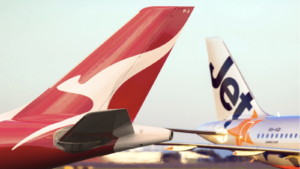‘This is the worst it’s ever been:’ An interview with former American Airlines Chairman Bob Crandall

What we'll be covering
This article originally appeared on AirlineGeeks. Further edits made by Daniel Sciberras
Airline industry tycoon Bob Crandall is no stranger to the peaks and pitfalls of the airline industry. As the former president and chairman of American Airlines from 1985 to 1998, Crandall is known for his unique cost-cutting strategies and outspokenness when it comes to investing in airlines.
Long since retired, Crandall spent a significant amount of his professional career in the commercial airline business, including roles at TWA and American. He was widely looked upon favourably during his tenure, pioneering electronic reservation systems, frequent flyer programs, among other achievements. In fact, there’s even a webpage about him, seemingly made by airline employees, called BringBackBob.org.
Crandall spoke with Point Hacks syndicated partner, AirlineGeeks in December about COVID-19 and its impacts on the airline industry. While the interview focuses on the United States, it easily applies to the aviation industry the world over.
This is a transcribed interview with some pleasantries edited out and further small edits made for ease of reading.
AirlineGeeks Founder Ryan Ewing (RE): You know, it’s no secret right now, that airlines are hurting. Do you think this is the worst it’s ever been in commercial aviation history?
Former American Airlines President Bob Crandall (BC): Yes. I think this is the worst it’s ever been. It’s very strange because all of a sudden, you’ve got a tremendous amount of capacity that’s been built in order to accommodate an ongoing high level of demand, and all of a sudden, that demand’s gone. So there just isn’t any good way to get over this problem.
RE: What should airlines be doing right now to position themselves?
BC: I think they’re doing everything they can do. They’re reducing their costs, they’re trying to pull down as much capacity as they possibly can and try to sustain some capability to resume, to continue operations until after demand restores itself. So, they’re doing all the right things.
RE: I guess tagging onto that question, and you can answer this more from a revenue standpoint, or a cost standpoint, how airlines, you said they brought down capacity, why not put as was done in the past, widebodies on heavy traffic routes that have the demand right now. I mean like Phoenix to Dallas is a perfect example.
BC: But the problem Ryan is, if you got to put on a widebody, you’ve got to reduce frequency, right. And the market wants frequency.
RE: And they’ve reduced frequency so much. So, why did it work back then? Widebodies were very common thing to see on domestic hauls. Why do you think that dynamics change and especially now?
BC: What dynamic has changed?
RE: The dynamic in terms of putting heavier airplanes that can accommodate more people on domestic routes.
BC: I think you’re confusing yourself. Frequency has always been desired. This is what the public wants, it was frequent flights. It does not want a few flights on big airplanes. So, the industry, if they’re going to serve the public properly, isn’t going to use bigger equipment until it already has enough frequency.
RE: Here’s another one for you and I use this term a lot. The airline industry can be cyclical. I mean I don’t know a better way to describe it.
BC: What’s cyclical?
RE: The airline business, just in general, up and down. You’ve been a veteran of it. What do you say to somebody that’s just getting started in this business?
BC: That’s just starting in the business.
RE: Yes, they’re just getting started.
BC: You’re talking about an employee?
RE: Yes.
BC: I think this is a strange time to start in the airline business. As a matter of fact, I don’t think anybody is just starting. The airlines are all laying off people. So, they’re not going to be hiring anybody.
RE: I mean, do you have any advice for people that might feel uncertain about it?
BC: Uncertainty about what?
RE: About the COVID situation and the dynamic of it on our industry?
BC: Ryan, I don’t know what you’re asking me. What are you talking about?
RE: I’m trying to find a good way to position it here so it makes sense. So, let’s say, you know, you have somebody on day one just starting. It could be anybody.
BC: Who is day one? They’re not going to start for the next three years.
RE: That makes sense.
BC: So that’s an irrelevant question at the moment.
RE: Does a path to normalcy start with more government funding, do you think?
BC: I think the government probably ought to be providing some incremental funding, mostly to keep the industry viable in the long term. But the point is, if the government doesn’t provide any more funding, I think the industry can fund itself. It’ll just take longer to dig out of the hole.
RE: Do you think by the government funding airlines, it’s delaying the inevitable, especially with the original CARES Act.
BC: Do I think government funding is delaying the inevitable? I don’t think anybody knows the answer to that question. That question depends on whether or not the legacy carriers are able to reduce their costs in the long run. And nobody knows the answer to that question yet. It all depends on their relationships with the unions.
RE: Is now a good time to invest in a U.S. airline, Bob, or is there ever a good time?
BC: Well, there never was a good time to invest in airlines. You know, if you’re sort of a riverboat gambler. Yes, they’re all a lower price now than they have been in the past. If you think that carrier A or carrier B is likely to prevail in the longer term, then I think yes, it probably is a good time to invest in those carriers, since all the carriers are cheap relative to the past. It’s probably a good time to make an investment, but you better pick the right one.
RE: Do you think this whole pandemic, do you think it just changes the [industry] landscape?
BC: No, I don’t think it changes the landscape at all.
RE: You know, with the low-cost carriers and everything.
BC: I don’t give a sh*t about the low-cost carriers. I just told you a minute ago. If the legacy carriers cannot get their costs down to match the low-cost carriers, they’re finished. So, the question is, will they get their costs down? I don’t know. You know, [we probably won’t] know for 10 years.
RE: This leads to my next question. When do you expect some sort of recovery? Ten years, five years, three years?
BC: What, for the industry as a whole?
RE: Yes.
BC: I think three years from now the demand will be back where it was before.
RE: So, you do think we’ll reach 2019 levels again?
BC: In terms of the number of people carrying?
RE: Yes, load factors.
BC: Yes.
RE: I guess down the road, I mean, where do you see the industry going from here? Do you see a lot more cuts? I mean, to service, to operations, even if the numbers do return?
BC: Demand will return.
RE: Interesting. That’s all the questions I have.
BC: Look Ryan, if you think the entire United States is going out of business then that’s different than if you think that the economy will recover after the pandemic. If the economy recovers, demand will come back, and if demand comes back, the industry will get back to the passenger traffic levels of 2019. If the world comes to an end, that’s a different matter.
RE: Do you think there’s a linkage between the caseloads, you know, whatever the case counts in various states and load factors, or do you just think people want to travel to places that they can go to and enjoy a nice meal at a restaurant?
BC: I think people just want to travel for the sake of seeing other people and seeing places.
RE: Based on what you’ve seen from all our airlines in the U.S., would you travel?
BC: Oh no, because I’m old and I don’t want to get COVID. I’m not going anywhere until I get a vaccination.



Community